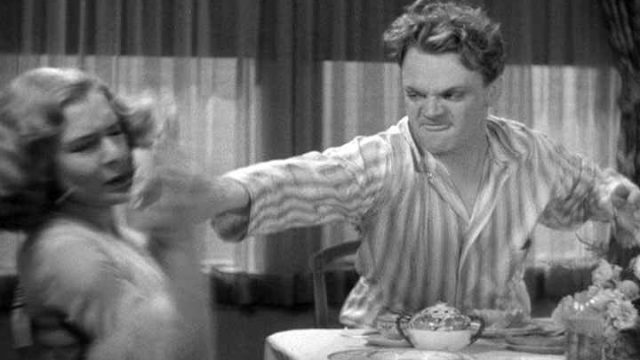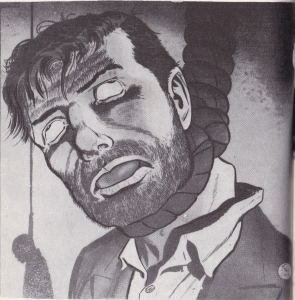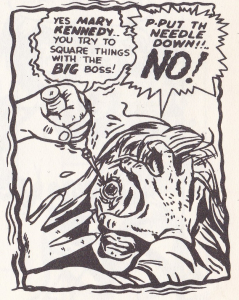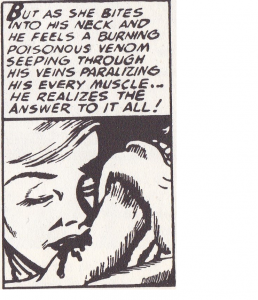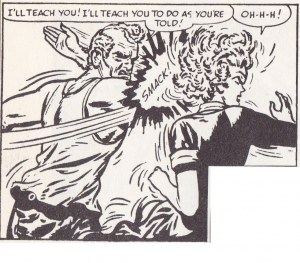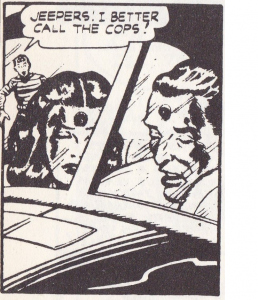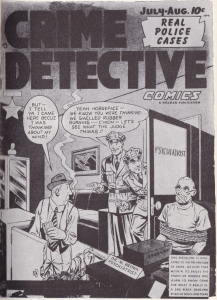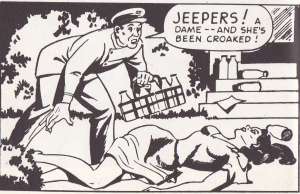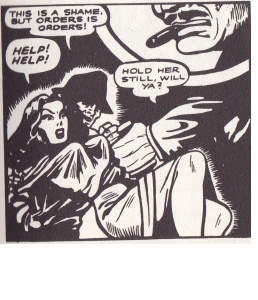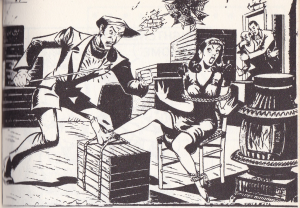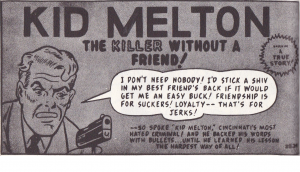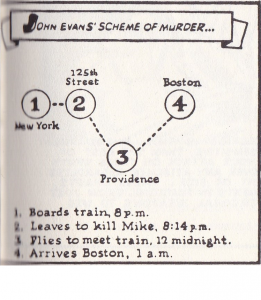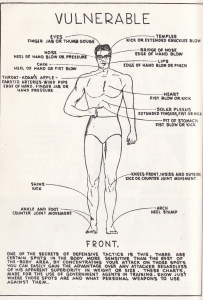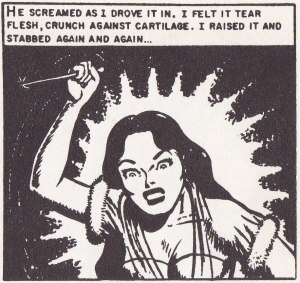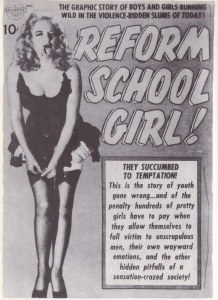This section is the most egregious offender of the “he never mentions where anything is from” adventures in the whole book. While Dr. Fredric Wertham initially wrote what he called a bibliography for insertion into the book, which his publisher removed on protest from the comics publishers—first edition copies will still have evidence of the page cut out—it was merely a list of said publishers. It didn’t mention artists, writers, publishers, issue numbers, or anything else to do with where he got the images that comprise the photo insert. While I passionately believe Wertham’s reproduction of the images qualifies as “fair use,” as my own use of his use does, I still think it’s pretty sleazy of him not to identify them. Especially because later research has shown how blatantly out-of-context some of his usage was.
I cannot take credit for tracking all these down; other people on the internet have done wonders in that department. I would especially like to thank the fine people at the extremely useful but poorly designed http://www.lostsoti.org , who have tracked down not only the images reproduced in this section but many of the comics vaguely referenced elsewhere. So let’s get to it, shall we?
I first read Seduction of the Innocent in college. My alma mater actually keeps on its shelves a library-bound hardcover that is a photocopy of the book. I almost want to donate my own copy after I’m done here, because my copy is better than theirs. At any rate, I happened to read it after I’d also encountered on the library shelves Stephen King’s Danse Macabre, his examination of horror as a genre, particularly between the years of 1950 (when he first started really noticing things) and 1980 (approximately when he was writing). He lingers for a while on EC and its gleeful treatment of poetic justice. The punishment, King assures us, always fits the crime in EC. He insists it’s evidence of the true morality of EC.
Therefore I was, not long after, astonished to find this particular image in SotI. You see, King lovingly details this entire comic as an example of morality; Wertham details it inasmuch as he does as an example of the immorality of comics. (He never mentions EC in particular, any more than he mentions any other publisher who isn’t Disney.) It’s a pretty horrific couple of panels, I don’t deny. However, what Wertham leaves out by depriving us of any context is that it’s the punishment given to a baseball player who kills other players with poisoned spikes. Gruesome? Macabre? Certainly. Vigilante justice? Assuredly. But still its own sort of morality.
It’s the only one I knew from context without the help of the internet, though. So understand that, yes, I’m using the internet, here. Which is also how I know that it is specifically Haunt of Fear issue 19.
There’s not much to say about the second illustration, which is, as the caption tells us, the “Cover of a children’s comic book.” (Leaving aside Wertham’s persistent use of “children” to mean everyone from birth to eighteen and sometimes beyond, of course!) Specifically, it is from Crime SuspenStories issue 20.
Two of the images on the third page are from True Crime Comics Volume 1 #2. One is the dragging image, captioned, “Pity was the keynote when Homer described dragging a dead body behind a chariot. Dragging living people to death is described without pity in children’s comics.” The other is the person getting stabbed in the eye, naturally captioned, “A sample of the injury-to-the-eye motif.” Here, of course, my issue is not so much context within the comic as context within literature and history, but yeah, that’s Wertham for you.
The third image from that page is Crime and Punishment issue 59. Even without reading the comic, it seems obvious to me that the comic is not using this, as Wertham calls it, as an example of “What comic-book America stands for” but instead an observation of what has actually happened, over and over, through the history of the US.
The next image is from Fugitives From Justice issue 3. This one, I have read—thanks to http://www.comicbookplus.com , which maintains a gallery of scanned comics used in SotI, but which I found too late to get to all of them. Yes, all right, the girl is half-naked, and it’s implied in the story that she and the villain are, shall we say, cohabitating without the benefit of clergy. Is that what Wertham means when he captions it, “An invitation to learning”?
Next we have a panel from Women Outlaws issue one, captioned “Giving children an image of American womanhood.” Alas for all of us, Wertham doesn’t seem to quite get the idea that there are many different kinds of American womanhood, and many of the children with whom he interacted had dealt with similar in their day-to-day lives.
I’ll confess I was disappointed to discover that the movie Pillow Talk came out in 1959, because there are stills from it that would be a great counterpoint to Wertham’s caption here of “Erotic spanking in a Western comic book.” This particular image is from Frontier Romances issue 1, but Wertham’s shock to the contrary, I can find a lot of similar images from a lot of media at the time, much of which was intended to be suitable for children. (McClintock! is ’63, and spanking goes right on the poster!) Hell, there’s erotic spanking in Taming of the Shrew!
I don’t have any context from Weird Mysteries issue 7 to put that woman’s torso into perspective. I’ll frankly admit that Wertham’s probably right, and it’s probably there to say, “Look! Here’s a sexy woman’s torso!” Headless, even. And the “With plenty to offer . . . .” in the narration box isn’t helping.
However, the next image is from the same comic. Wertham captions it “Sex and blood,” which is pretty much what’s going on. But come on, Wertham—haven’t you ever read Dracula?
The next four are not only close-set on the page, but two of them overlap. The first is, as Wertham actually tells us, from a comic called First Love, specifically issue 35. But without further context, can we know if the comic condones what’s happening? And his protestations to the contrary, isn’t that sort of causal brutality against women fairly common in media? Even if it’s condemned, it’s still there.
The next one is from Beware issue 1, and I guess all I really have to add is “Citation Needed,” which is so often my reaction. His caption here is “Children are first shocked then desensitized by all this brutality.” Once again, I don’t dispute that what’s happening is fairly vile, but does he have evidence that this image and others like it are what have desensitized children to violence? Or, indeed, that they’ve been desensitized?
I haven’t read Law Against Crime issue 3, so I don’t have anything to say about context, but seriously, Wertham, two “Citation Needed” captions in a row? Because here, he says, “The wish to hurt or kill couples in Lovers’ Lanes is not an uncommon perversion.” Is that true? Who knows? I can only think of one serial killer who regularly did it, so I’m inclined to suspect not.
Thing issue 9 provides us with our next image, captioned, “Stomping on the face is a form of brutality children learn early.” As if it weren’t, to be honest, a completely logical way of injuring people. The face is vulnerable, and if you’re in a position where you can stomp someone in the face whom you wish to harm, well!
The makers of Crime Detective Comics must have felt a great deal of satisfaction in putting their Wertham caricature on the cover of issue 9. I can’t help wondering if it was worth it, though, since this sort of thing probably just drew more ire from him and heightened his resolve.
I’m pairing these two images from Jungle Comics issue 98 together, since one is just a detail of the other. And, guys, seriously. Okay, so the anatomy on this guy isn’t the world’s most accurate. But do you really think the artist was that hard up to draw naughty bits of women that he hid them in this guy’s shoulder? Yes, when Wertham highlights it the way he does, you can kind of see it if you squint. But you have to, don’t you?
Actually, I’ve read Crime Smashers issue 1, or at least the relevant story, and the comic never says the women are “raped,” for all Wertham says, “A girl [not woman, note] raped and murdered.” “Attacked,” but let’s face it—the way they’re murdered, that’s an attack. They’re strangled, I believe, so disheveled clothes make sense. Am I saying the woman hasn’t been raped? No, I’m not, and indeed one panel seems to almost vaguely hint at a gang rape. On the other hand, that’s accidental, since the other people in the picture are actually cops rushing to attempt to catch the killer! In this case, I really do think Wertham is reading something into the story that isn’t there.
When it comes to Phantom Lady issue 17, he does have more of a point. He captions it with “Sexual stimulation by combining ‘headlights’ with a sadist’s dream of tying up a woman.” I mean, okay, he’s confusing bondage with sadomasochism, and while the two are related, they aren’t at all the same thing. Still. Headlights.
Likewise on the badly drawn image from Blue Beetle issue 54—man, are those some prominent breasts. I do wonder how young the children he’s talking about are when he says, “Children call these ‘headlights’ comics.”
These four assorted images, all jointly captioned, “Treating police contemptuously is a common occurrence,” are probably a relatively accurate sampling, unto the gorilla. It’s a weird truism of the comics industry that comics with gorillas on the cover sell better. No one seems to know why. Anyway, one of the four remains uncertain, I think, and the other three are from Justice Traps the Guilty issue 58, Strange Adventures issue 39 (I suspect that’s the ape), and Hunted issue 13.
While I don’t doubt that “Children told me what he was going to do with the red-hot poker” in Crime Reporter issue 2, seriously, it’s not difficult. The woman has a bare foot tied to a box. The man has a poker and is threatening her. What do they have to do, draw you a map? (Also, has Quentin Tarantino seen this comic?) And, again, there’s Wertham’s vague use of “children.”
The caption on this image from Giant Comics Edition issue 4, previously issued in Red Seal issue 16, intrigues me. We’ve spoken before, and often, about how clueless Wertham is about pop culture. But can he really believe that “Outside the forbidden pages of deSade, you find draining a girl’s blood only in children’s comics”? Because again, Dracula.
Likewise, I am intrigued here. Though you couldn’t prove it by me whether those people are alive or dead, I still don’t entirely dispute Wertham’s captioning of this image from All-Top issue 14 with “Corpses of colored people strung up by their wrists.” However, I am extremely curious about what he’s cut off with this cropping. Because while I did crop each picture from scanned pages from my own copy of the book, I didn’t cut anything more than a few pixels on the borders of any given image. Wertham cut this one.
Lawbreakers Always Lose issue 7 presents us with what Wertham calls “Comic-book philosophy,” still ignoring that you can tell the story of someone with whose perspective you do not agree.
Let us now examine two images together. He accuses the latter, taken from Gang Busters issue 3 and captioned “Comic-book map for crime,” with inspiring the former, captioned “Children’s drawing found by police on boy-burglars.” The two are joined by an all-caps notation, “MODERN JUVENILE DELINQUENCY INVOLVES KNOWLEDGE OF TECHNIQUE.” Which I suppose is true. But does he really believe that no one drew basic maps of their crimes before comics? Does he not believe that children—one assumes teenagers in this instance—could maybe thing of it on their own?
Likewise, if he thinks children might rely on Exposed issue 6 to learn how to create an alibi (which, note, involves an airplane, something the average child might have difficulty managing), he’s a seriously confused man. But Wertham assures us this is “How to create an alibi.”
Which he must be, because let’s ponder Exposed issue 7 for a second. All right, it’s true that the diagram in question is the solution to a crime. However, this diagram would not help anyone break in to a locked window, because the diagram shows how someone locked a window behind him to create a locked-room mystery! “Diagram for housebreakers,” Wertham? Not hardly! Actually, I want to read Exposed now, because it looks like mysteries that rely on clever tricks for the solutions, not unlike some of the mystery novels I read.
Top Secrets issue 7 gives us this self-defense diagram, simply labeled in the book “How to hurt people.” Which, yeah, it is. Any self-defense trick can also be used to be the aggressor. Doesn’t mean self-defense isn’t worth teaching.
I didn’t have to look to be told that the next collection are from EC, specifically Weird Science issue 19. It’s creepy, yes. But was there some rash of kids stabbing people with hatpins that I don’t know about? And spoilers! “A young girl on her wedding night stabs her sleeping husband to death with a hatpin when she realizes that he comes from a distant planet and is a ‘mammal.'”
I also want to know who’s labeling Reform School Girl, the cover of which makes it look like it’s not even a comic, as “supposed to be like fairy tales.” While I agree that a lot of comics got more child readers than people liked to admit, you know, this looks like the kind of trashy rag that vendors would shout at kids to keep away from. And those certainly didn’t go away with the coming of the Code!
So yeah. Draw your own conclusions, here, folks, because goodness knows Wertham did. Also, seriously, thank you to Graham, who owns a scanner and did the scanning of these images for me. I’m afraid I’m not savvy enough on the software to remove all the unnecessary white space on the images.

